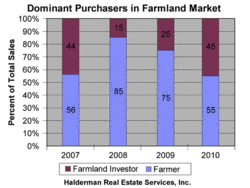
Dismal returns on US Treasuries and stocks are encouraging more investors to buy farmland. (DTN chart)
Land appeals as safe haven
Surge of nontraditional buyers lessens threat of downturn in farmland values
Marcia Zarley Taylor
DTN Executive Editor
HADDONFIELD, N.J. (DTN) -- It's not just the summer of $7 corn that superheated Midwest land markets. Investors rattled by the prospect of a double-dip recession still see U.S. farmland as a safe haven amid economic turmoil. That surge of nontraditional buyers lessens the threat of a downturn in farmland values anytime soon, real estate and Wall Street experts contend.
Since 1993, farmland owners have averaged returns of about 12.1% annually counting cash rents and appreciation, Howard Halderman, a real estate adviser who manages farms in 21 states and consults for a 600,000-acre South American farm venture, said at a DTN investment webinar Sept. 29.
But the panic that has driven 10-year U.S. Treasuries under 2% in recent weeks lowers the bar for what competing investments like farmland need to return over time, said John Maddux, a Nebraska native who spent 12 years on Wall Street with Goldman Sachs before returning home to manage his family's 125-year-old cattle ranch.
Investors see 10-year or 30-year Treasuries as the "risk-free" interest rate and use that as a benchmark to compare all other interest rates and risks, Maddux said. By that standard, farmland has a "low hurdle to overcome."
Investors now compose about 45% of today's farmland purchasers, compared to 15% in 2008, said Halderman. The bulk of those nonfarmers tend to be individuals rather than pension funds or insurance companies, but that composition could shift given economic turmoil. According to recent Illinois farm realtor and appraiser surveys, about 7% of the state's farmland buyers are institutional owners.
In other parts of the world, investor funds are scooping up large tracts of land. In Brazil, government surveys found foreigners owned 10% of the nation's cultivated land. Much of that was funds with international backing in London or New York.
"The real number is probably higher because the data is incomplete on land owned by Brazilian companies controlled by foreigners," DTN South American Correspondent Alastair Stewart said. When the government announced new rules governing foreign farmland investment in 2010, some $15 billion in projects were put in limbo, he added.
Even so, Brazilian farmland prices are still rising and could approach 20% gains in 2011, Stewart said. He expects the government to revamp foreign ownership guidelines by the end of the year.
Maddux, a former board member for a $9 billion public pension fund, believes farmland still offers attractive diversification to institutional owners given record-low Treasury rates.
Typical 2011 returns on irrigated land in a corn-soybean rotation in the eastern part of Nebraska more than top 10-year Treasuries, even before capital gains, Maddux said. That's also true for Nebraska irrigated farmland now priced at $7,500 per acre; investors and farmer owner-operators can conservatively project 2.37% to 4.28% cash returns even at that lofty land value.
"The Holy Grail for all investment managers is that they're looking for some kind of asset that is not strongly correlated with their core equity positions," Maddux said. Since 2007, farmland has negatively correlated with stock indexes like the Wilshire 5000, so it has continued to appreciate while stocks plunged.
"If you believe that current Federal Reserve policy is setting up the economy for a major inflation event," farmland also holds appeal, Maddux added. Some economists believe that inflation events occur about 90 months after huge monetary shocks -- like the Federal Reserve's massive monetary response since 2008. By that score, farmland purchased today could be a good hedge should inflation escalate starting three or four years from now, Maddux said.
Just how far and fast farmland appreciates depends on the cash flow it generates, both Halderman and Maddux emphasized. Historically, investors aimed for a 4% or 5% cash rent return, based on current values. That might not be necessary, given anemic returns for other low-risk assets like farmland.
If cash rents or capitalization rates on farmland slip to 3% or lower, we'll know we've hit the high in farm real estate, Halderman said. But based on early rent negotiations for 2012, he doesn't see that scenario materializing.
"In fact, cash rent increases look like they're going to jump substantially," he added. "While $10,000/acre seems like a ridiculous amount of money for farmland versus five years ago," it's sustainable as a long as farm incomes stay at these levels.
Corn is suffering a harvest low at the moment. But sustained declines in corn prices are the key to watch, both Halderman and Maddux stressed, even though both are optimistic about agriculture's future.
"I haven't seen the world financial situation any more precarious than it's been right now," Maddux said. "There is great potential for major financial shocks to the world economy. There are major problems in Europe and not a good consensus to attack the debt issue there. There's been enormous run up in all kinds of assets in Asia and China, with residential and commercial real estate possibly overvalued in any world downsizing. So any decline in the value of corn could be a potential land mine for farm real estate."
To watch a 60-minute rebroadcast of DTN's webinar, "Buying the Farm: Strategies for North and South American Land Investment," go to https://dtn.webex.com/dtn/lsr.php?AT=pb&SP=EC&rID=21678357&rKey=48d33902a4ac1112
Marcia Taylor can be reached at [email protected]
(AG/CZ)












